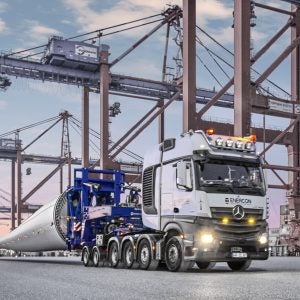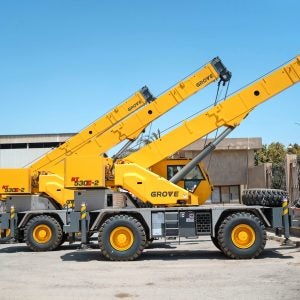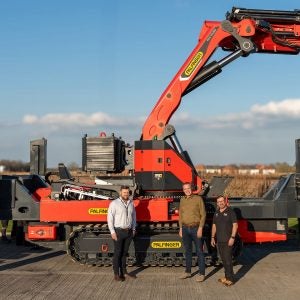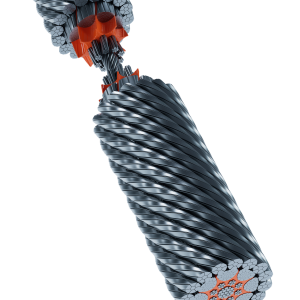A good start
Manitowoc started the year on a high, reporting full year 2007 results in February that showed crane sales up 49% to $3.245bn. Over the last quarter of that year, the growth was even more impressive, with sales up 56%. The company’s backlog at the end of 2007 stood at $2.9bn, and rose to $3.52bn by the second quarter of 2008.
Terex joined the celebrations, announcing full year crane net sales up 28% to $2.23bn and a crane order backlog over $2bn for the first time. In July, Terex announced second quarter crane sales up 48.7% to $809.8m. Overall sales were $2.94bn across the group, up 25.3% compared to 2007.
Specialist manufacturers were enjoying the good times too. Palfinger announced a record-breaking 2007 when its results came out in February, showing sales revenue up 19% to EUR695.6m, and earnings before interest and tax up 29.4% to EUR99.6m.
In Asia, manufacturers were claiming strong growth too. Kobelco sold 850 cranes in its 12 months to March, netting JPY 71.2bn, up 26% compared with the previous year’s takings. At that time, it forecasted that sales for the next year to March 2009 would rise 30% again to JPY 93bn. Sany Group, reporting unaudited figures for 2007 in March, said it had made sales of CNY13.5bn ($1.8bn), a 65% increase on the previous year.
In the rental sector, results were also up. Singaporean rental firm and dealer Tat Hong reported in May that its sales for the year to March 31 had risen by a third to SGD640m. The company’s crane rental division reported the highest growth in the group, rising 85% to SGD167m. In August, the company said first quarter revenues had risen 39% to SGD191.3m. Crane rental delivered gross profits of SGD28m.
New capacity
The boom put pressure on manufacturers, both in terms of their own capacity, and supply of components. Suppliers stepped
in to meet the demand with new investments. In the Czech Republic, steel supplier Slevarny Trinec, which exports to customers such as Sennebogen, said it was beginning an expansion programme that would raise production by 7,000t, to 24,000t, by 2010. In the USA, Bridgestone Firestone North American Tire said, in January, that it would invest $12m over five years on
new capacity at it its Bloomington, Illinois, offroad tyre plant.
Crane builders also increased production capacity. Manitowoc opened a new Potain tower crane factory in Velky Saris, Slovakia, in June. The plant was the company’s first to designed from the start around lean manufacturing principles. At the time of the launch, it said it would be producing MDT 178 topless towers and MD 208A top slewing towers, for sale in Russia, Eastern Europe, and CIS countries.
The new Slovakian plant was followed by the completion of two major expansion projects, at Niella, Italy, and Shady Grove, Pennsylvania, USA. The Shady Grove expansion opened in September. It added 4,600 sq m to the boom crane plants final assembly hall, and 920 sq m for boom assembly.
The Italian plant was opened in October. Work on a new 5,000 sq m hall had begun in 2007, and production started this year. With the expanded plant, Manitowoc was bale to move all of its two and three axle all terrain production to Niella, allowing it to free up capacity for larger all terrains at its Wilhelmshaven, Germany, plant.
In Nenzing, Austria, Liebherr completed the first stage of a massive building project in July, beginning production of piling and drilling rigs in a new 12,000 sq m assembly hall built during 2007. The manufacturer plans to spend a further EUR70m on new buildings at Nenzing, including a new two storey robotic welding plant for boom sections that will increase the work area by 50,000 sq m.
German crane and excavator manufacturer Sennebogen opened a second assembly factory in Straubing, Germany. It reported that output increased 30% compared with 2007 (sales increased 45% to EUR 360m).
Sany announced plans for a series of new manufacturing plants around the world, including a new EUR60m plant near Cologne, Germany, announced in October. The company also started work on new plants in Georgia, USA, and Pune, India.
Dealmaking
In the rental sector, mergers and acquisitions, often backed by private funding, continued to play an important role in business development. In the oil sands region around Alberta, Canada, Northen Crane and its backers Northwest Capital Appreciation have been building a major crane and transport business. In January, it bought specialist transport firm Trans Tech Consulting. That deal was followed in April by the acquisition of Mullen Crane & Transport, across the US-Canadian border in Idaho. In September, the company made a deal closer to home, buying Parkland Crane Services.
At the other end of North America, TNT Crane of Houston, Texas, bought Corpus Christi-based Kuhn, in June. Talking about the deal in Cranes Today’s ‘In our fleet’ column, CEO Mike Appling (who led a leveraged buy out of TNT last year) said, “Having more branches gives us more utilisation of larger cranes. Our goal is to do one or two acquisitions a year.”
There were important deals for three of the US’s most well known crane firms. In March, investors Kirtland Capital Partners sold Essex Crane Rental Corp to South African investment vehicle Hyde Park Acquisition Partners. In November, Hyde Park announced it would be listing on Nasdaq, under the name of its new purchase.
In July, Platinum Equity completed the purchase of Maxim Crane. Built through a series of acquisitions, Maxim had struggled financially, spending some time in bankruptcy protection. The deal marked a significant turning point for the company.
In October, Memphis, Tennessee, based Barnhart Crane and Rigging continued with plans to break out of its traditional territory in the Southeast USA, with a second acquisition covering the north of the country, Connecticut-based Marino. The deal added 100 employees, 75 cranes, and 130 lines of Goldhofer trailers to Barnhart’s fleet. Marino will continue to operate under its own name.
Expansive Belgian tower crane sales and leasing firm Arcomet continued its growth, with a new business based in Singapore, announced in March. Arcomet bought two Singapore businesses, Comedil distributor Y&P Marketing and Comedil rental firm GMA. The new business, Arcomet Asia, created two joint ventures, with Height Tower Cranes of South Korea and Hontrade of Hong Kong.
At the end of October, the Belgian firm announced another new joint venture, this time in Ukraine. The new Lviv-based rental firm will start operations in western Ukraine with five cranes, and plans to expand its fleet and service area through 2009.
Arcomet looks likely to continue its expansion, after a deal that saw CEO Dirk Theyskens and his management team buy out three minority investors who had helped fund the firm’s growth since 2000. The deal, backed by Belgian private equity fund Sofina and French bank Lazard, made EUR200m available for further acquistions.
Dealmaking wasn’t confined to the rental and distribution sector. In February, Finnish steel component manufacturer Rautaruukki bought German boom manufacturer Wolter Metallverarbeitung. Wolter’s most instantly recognisable product is probably the huge vertically telescoping mast used in Manitowoc’s innovative GTK 1100.
The US’s two biggest crane builders, Manitowoc and Terex, both made major deals in 2008.
In March, Manitowoc announced it had acquired a 50% stake in Chinese truck crane manufacturer Tai’An Dongyue. Eric Etchart, president and general manager of Manitowoc, told Cranes Today, “We want to be manufacturing the closest we can to the market, and China is the fastest growing construction market in the world.” The company said it would be showing three new cranes at Bauma China, in November.
Manitowoc’s name was linked to another big deal, when lawyers for port crane manufacturer Fantuzzi named it, along with Terex, Kalmar and Konecranes as potential buyers for the Italian business. Fantuzzi had struggled with financial problems, missing an important deadline for a EUR55m bond repayment in July. In August, it was announced that Manitowoc’s US rival, Terex, had agreed to acquire the business.
Many commentators framed the EUR215m deal as a match for Terex’s PPM reachstacker business. Speaking to Cranes Today days after the agreement, Terex cranes president Rick Nichols put the deal, and Terex’s view of itself, in a different context, saying: “Fantuzzi adds a product portfolio to allow us to extend further into ports and intermodal transportation.” Terex received EC?approval for the deal in November, only to tell the SEC two days later that it was seeking more information from Fantuzzi and may not complete the deal.
Giant cranes
As the malaise in the housing market, and residential construction, spread from the US to Europe, both manufacturers and rental companies stressed the importance of other sectors, such as energy and infrastructure, and the big cranes that service them. Tiong Woon, for example, stressed the importance of the contribution of its heavy lift and haulage division in a number of results announcements.
Essex Crane Rental said, in an unaudited revenue report released in June, that a $22m investment in new heavy cranes had helped increase actual crane rental days over the three months to March 31 to 71.8% of total available days, from 68.1% the year before. The investment helped push average rental revenue rates up 27.2%.
The renewed focus on heavy lift came as crane builders announced plans for some record-breaking new products. At ConExpo in Las Vegas, in March, Manitowoc announced plans to build its biggest crawler, the 2,535 US ton Model 31000.
The single boom crane will feature an innovative self supporting, adjustable, counterweight. So far, two customers have been confirmed, Bulldog Erectors and Crane Rental Corp, both of the USA.
Shortly after the US show, Liebherr announced plans for one the world’s biggest offshore slewing cranes, the MTC 78000, which will be able to lift 1,600t at 35m, or 600t at 70m. The crane is currenttly under production in Germany, with the first model due to be installed in early 2009. The company also announced it would be building the world’s biggest telecrawler, by mounting the upper from its 1,000t-capacity LTM 11200 on a crawler base.
In September, heavy lift specialist Abnormal Load Engineering, announced it had completed testing of its own giant crane. The SK 90 uses strand jacks, mounted on twin crawler style lattice booms, to lift up to 4,300t in heavy lift mode, or 2,600t in luffing mode. ALE will be keeping the crane for its own operations.






